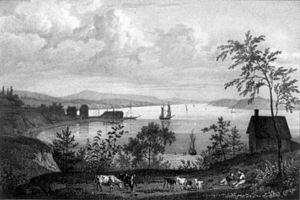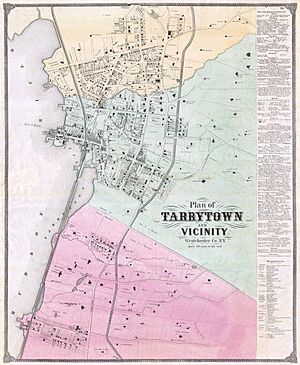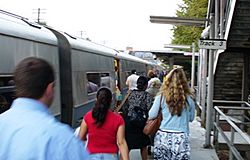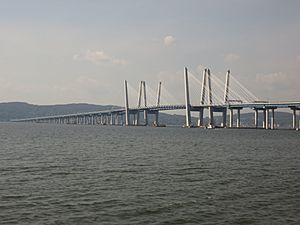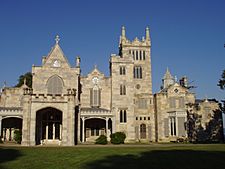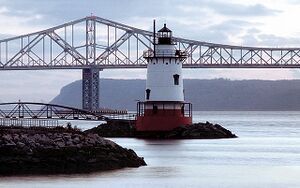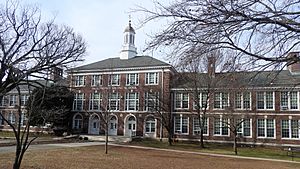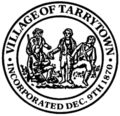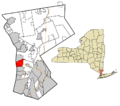Tarrytown, New York facts for kids
Tarrytown is a charming village located in Westchester County, New York. It sits right on the eastern bank of the Hudson River, about 25 miles (40 km) north of New York City. It's a well-known spot, especially because the Tappan Zee Bridge crosses the Hudson River here, connecting Tarrytown to Rockland County. In 2020, about 11,860 people lived in Tarrytown.
Quick facts for kids
Tarrytown, New York
|
||
|---|---|---|
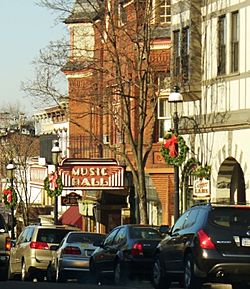
Main Street, showing the Music Hall
|
||
|
||
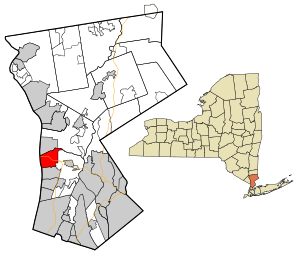
Location of Tarrytown, New York
|
||
| Country | United States | |
| State | New York | |
| County | Westchester | |
| Town | Greenburgh | |
| Incorporated | 1870 | |
| Area | ||
| • Total | 5.69 sq mi (14.73 km2) | |
| • Land | 2.94 sq mi (7.60 km2) | |
| • Water | 2.75 sq mi (7.13 km2) | |
| Elevation | 121 ft (37 m) | |
| Population
(2020)
|
||
| • Total | 11,860 | |
| • Density | 4,039.51/sq mi (1,559.82/km2) | |
| Time zone | UTC-5 (EST) | |
| • Summer (DST) | UTC-4 (EDT) | |
| ZIP Code |
10591
|
|
| Area code(s) | 914 | |
| FIPS code | 36-73176 | |
| GNIS feature ID | 0967065 | |
Contents
History of Tarrytown
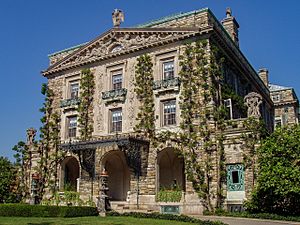
Before Europeans arrived, the Weckquaesgeek tribe lived in this area. They were Native Americans who fished in the Hudson River for shad and oysters. Their main village was called Alipconk, which means "Place of Elms."
Early European Settlement
The first European settlers in Tarrytown were Dutch farmers and fishermen. Records show that the first Dutch home was built here in 1645. The Dutch called the area "Terwe Town," which means "Wheat Town." This was because the soil was perfect for growing grains like wheat. Over time, people mispronounced the name, and it became "Tarrytown."
Revolutionary War Incident
A famous event during the American Revolutionary War happened in Tarrytown in 1780. A British officer named Major John André was arrested as a spy. He was traveling through the village when three local soldiers stopped him. They found secret papers hidden in his boot. This discovery helped reveal the plans of Benedict Arnold, an American general who was secretly working with the British. André was later found guilty and executed.
Washington Irving and Famous Homes
The famous writer Washington Irving described Tarrytown in his well-known story, "The Legend of Sleepy Hollow." He wrote about the "small market town or rural port" known as Tarrytown.
Many wealthy New Yorkers later chose Tarrytown as their home. One of them was John D. Rockefeller, who moved here in 1893. His grand mansion, Kykuit, was finished in 1906.
Tarrytown was also a stop on the Underground Railroad. This was a secret network that helped enslaved people escape to freedom before the American Civil War.
Historic Landmarks
Several important buildings and places in Tarrytown are listed on the National Register of Historic Places. These include the Christ Episcopal Church, the First Baptist Church of Tarrytown, and the Tarrytown Music Hall. The Tarrytown Music Hall is one of the oldest theaters in Westchester County. Two other famous homes, Lyndhurst and Sunnyside, are recognized as National Historic Landmarks.
For many years, a large General Motors car factory was located nearby until 1996. Today, the Metro-North Railroad's Hudson Line runs through that old factory property.
In 2014, Tarrytown was named the second-best place to live in New York by a real estate company called Movoto.
Geography and Climate
Tarrytown covers about 5.7 square miles (14.7 square kilometers). About 3.0 square miles (7.6 square kilometers) of this is land, and 2.7 square miles (7.1 square kilometers) is water.
| Climate data for Tarrytown, New York | |||||||||||||
|---|---|---|---|---|---|---|---|---|---|---|---|---|---|
| Month | Jan | Feb | Mar | Apr | May | Jun | Jul | Aug | Sep | Oct | Nov | Dec | Year |
| Mean daily maximum °F (°C) | 38 (3) |
42 (6) |
51 (11) |
62 (17) |
72 (22) |
81 (27) |
85 (29) |
83 (28) |
76 (24) |
65 (18) |
54 (12) |
43 (6) |
63 (17) |
| Mean daily minimum °F (°C) | 22 (−6) |
24 (−4) |
30 (−1) |
39 (4) |
49 (9) |
58 (14) |
63 (17) |
62 (17) |
55 (13) |
44 (7) |
36 (2) |
27 (−3) |
42 (6) |
| Average precipitation inches (mm) | 3.81 (97) |
3.33 (85) |
4.50 (114) |
4.54 (115) |
4.43 (113) |
4.36 (111) |
4.66 (118) |
4.47 (114) |
4.81 (122) |
4.57 (116) |
4.24 (108) |
4.38 (111) |
52.1 (1,324) |
| Source: The Weather Channel | |||||||||||||
Population Information
| Historical population | |||
|---|---|---|---|
| Census | Pop. | %± | |
| 1880 | 3,025 | — | |
| 1890 | 3,562 | 17.8% | |
| 1900 | 4,770 | 33.9% | |
| 1910 | 5,600 | 17.4% | |
| 1920 | 5,807 | 3.7% | |
| 1930 | 6,841 | 17.8% | |
| 1940 | 6,874 | 0.5% | |
| 1950 | 8,851 | 28.8% | |
| 1960 | 11,109 | 25.5% | |
| 1970 | 11,115 | 0.1% | |
| 1980 | 10,648 | −4.2% | |
| 1990 | 10,739 | 0.9% | |
| 2000 | 11,090 | 3.3% | |
| 2010 | 11,277 | 1.7% | |
| 2020 | 11,860 | 5.2% | |
| U.S. Decennial Census | |||
In 2000, Tarrytown had 11,090 people living there. About 77% of the people were White, 7% African American, and 6.5% Asian. About 16% of the population identified as Hispanic or Latino.
The average age of people in Tarrytown was 37 years old. About 19.7% of the population was under 18. The median income for a household was about $68,762.
Getting Around Tarrytown
Tarrytown is easy to reach by car, thanks to major highways like I-87 and I-287. The Tappan Zee Bridge is a key part of these highways, linking Tarrytown to other areas.
The Tarrytown railway station is a busy spot. Metro-North Railroad trains take commuters to New York City's Grand Central Terminal. Many people from Rockland County cross the Tappan Zee Bridge by bus to catch these express trains to Manhattan.
The Bee-Line Bus System also provides local bus service within Tarrytown and to nearby towns.
Places to Visit in Tarrytown
Tarrytown has many interesting places to explore:
- Lyndhurst: A beautiful Gothic Revival mansion.
- Sunnyside: The historic home of author Washington Irving.
- Tarrytown Music Hall: A very old theater, built before 1900.
- Tappan Z Gallery: A gallery featuring modern and fine art.
- Tarrytown Lighthouse: A historic lighthouse built in 1883.
- Washington Irving High School: A local high school.
Education in Tarrytown
Tarrytown is part of the Union Free School District of the Tarrytowns. This school district also includes most of Sleepy Hollow. The district has four schools for younger students and Sleepy Hollow High School. There is also a private school, the Hackley School, which teaches students from kindergarten through 12th grade.
Tarrytown was once home to Marymount College, a college for women. It closed in 2007. The campus is now used by the EF International Academy, a school for international students.
Culture and Community
Tarrytown is known as one of the "Rivertowns" along the Hudson. These towns are popular for their unique culture and lively atmosphere.
Religious Life
Tarrytown has many different churches, including Episcopalian, Baptist, Catholic, and Methodist. The Foster Memorial AME Zion Church is the oldest Black church in Westchester County.
The largest religious group in Tarrytown is Roman Catholic. There are three Catholic churches that serve the community. Tarrytown is also home to the motherhouse of the Religious of the Sacred Heart of Mary, a Catholic women's religious order.
Tarrytown also has a large Jewish community. Temple Beth Abraham serves both Reform and Conservative Jewish people. The JCC on the Hudson is a local Jewish Community Center that offers programs for families and educational opportunities.
Famous People from Tarrytown
Many notable people have lived in Tarrytown, including:
- Jacob M. Appel, author
- Cabell "Cab" Calloway, III, jazz singer and bandleader
- Barbara Bel Geddes, actress
- Washington Irving, writer and diplomat
- Caitlyn Jenner, Olympian athlete
- John D. Rockefeller, famous businessman
- David Sanborn, musician
- Jerome David Salinger, writer
- Mark Twain, writer
- Vanessa L. Williams, actress
Images for kids
See also
 In Spanish: Tarrytown (Nueva York) para niños
In Spanish: Tarrytown (Nueva York) para niños



